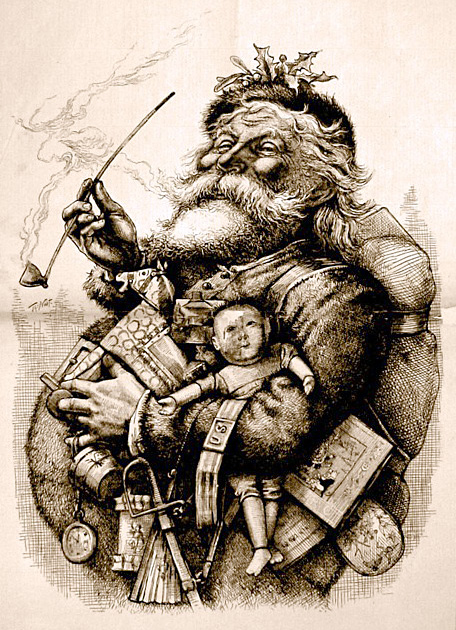* * * *

* * * *
December 17, 2023 – It’s that time of year again. Time to wonder – as if we don’t already have enough on our plate to worry about – Should Parents Tell Children the Truth About Santa? The short answer: Yes, there really is – or was – a Saint Nicholas. And actually, there are several foundational figures, prototypes for today’s “Santa Claus.” One of the first was Nikolaos of Myra.
He was a historic, bond fide 4th-century saint and Bishop of Myra (Demre, part of today’s Turkey). He was also called “Nikolaos the Wonderworker,” thanks to miracles “attributed to his intercession.” See Saint Nicholas – Wikipedia, and also Saint Nicholas … Britannica:
Saint Nicholas, also called Nicholas of Bari or Nicholas of Myra [is] one of the most popular minor saints commemorated in the Eastern and Western churches and now traditionally associated with the festival of Christmas. In many countries children receive gifts on December 6, Saint Nicholas Day.
To which I would respond: “He doesn’t seem to be such a minor ‘saint’ these days.”
And speaking of corruption – nothing new these days – that brings up the three innocent men sentenced to death, in the painting atop the page. It was the “corrupt prefect Eustathios” who imposed the sentence. (After accepting bribes to “bring about the deaths of three men.”) This first St. Nicholas “was not one to be intimidated by the power of others, especially the power of the corrupt.” Accordingly, he “stormed into the prefect’s office and demanded that the charges against the three men be dropped.” Eustathios eventually “confessed … and sought the saint’s forgiveness.” Nicholas forgave him, but only after the ruler underwent a period of repentance. Which led me to think: “Boy, we could sure use him today!!!“
Other stories told of Nicholas of Myra’s “love for God and for his neighbor.” Like providing dowries for three poor unmarried daughters. (Thus saving them from a life of prostitution.) Or of three children killed and “pickled” by a butcher – during a time of extreme famine and cannibalism – who planned “to sell them off as ham.” But Nicholas both “’saw through the butcher’s horrific crime’ and resurrected the three children from the barrel.”
And while it’s true that Christmas is only a week or so away, that famous festival is preceded by the Feast day of Thomas the Apostle (also known as “Doubting Thomas”), on December 21. And Thomas – in a big way – serves as a metaphor for all us “Doubters.”
That is, the term “Doubting Thomas” refers to a “skeptic who refuses to believe without direct personal experience.” But as I’ve noted previously, that’s just what attending church and reading the Bible is supposed to provide: A chance at a direct and personal experience with the Force that Created the Universe. See also The Bible and mysticism, which said that Christianity is all about “obtaining unity with God, through Christ.” So a mystic and a Christian both seek that “direct personal experience with God.:
In plain words there are two sides of the Christian experience: The “corporate” or business side, and the “mystical” side. The problem is that so many Christians get hung up on the “business side” of the Christian faith. Mainly because it’s so much easier… But it’s only the mystical side that can lead to a direct personal experience with God, and Thomas the Apostle is a reminder that – hard as that may be – it can be done….
On that note there’s the Wesleyan Quadrilateral, “a way to understand our four-sided approach to answering questions about Christian belief and practice.” Those four sides include Scripture, tradition, reason and experience. And of those four: “What Scripture teaches, tradition affirms and reason supports, must be experienced in Christian community and lives. Without authentic experience, we never move beyond the faith of the devils.” Put another way, “Apart from scripture, experience is the strongest proof of Christianity.”
So here’s wishing you first a happy “original Doubting Thomas” day, then a happy “real St. Nick” festival day. And that if you haven’t found it already, that in the New Year coming up you can find that “direct personal experience with God.” (But not necessarily in the same way as those three “innocents condemned to death” at the top of the page…)
* * * *

* * * *
The upper image is courtesy of Saint Nicholas – Wikipedia, with the caption: “Saint Nicholas Saves Three Innocents from Death (oil painting by Ilya Repin, 1888, State Russian Museum).” See also St. Nicholas Center … Saint Who Stopped an Execution.
The Book of Common Prayer reference. The “corporate-mystical” prayer is on page 339, the post-communion prayer for Holy Eucharist, Rite I.
Re: Santa. See also Should Parents Go Along With the Santa Myth? – Psychology Today.
For this post I borrowed from some of my earlier posts, On the original St. Nicholas (2014), On St. Nick and “Doubting Thomas” (2015), There really IS a “Saint Nick” (Virginia…), from 2017, and Santa saves three men, and “Doubting” shows the way (2018).
Re: Quadrilateral. See also The Wesleyan Quadrilateral – The Wesleyan Church.
The lower image is courtesy of Santa Claus – Wikipedia, captioned, “1881 illustration by Thomas Nast who, along with Clement Clarke Moore’s poem ‘A Visit from St. Nicholas,’ helped to create the modern image of Santa Claus.” As to the original, see St. Nicholas Center ::: Saint Who Stopped an Execution, which told of his hearing the news, then rushing to the site of the planned execution:
Informed that their execution was to be carried out that morning, he hurried to the executioner’s field. Here he found a large crowd of people and the three men kneeling with their arms bound, awaiting the fatal blow. Nicholas passed through the crowd, took the sword from the executioner’s hands and threw it to the ground, then ordered that the condemned men be freed from their bonds. His authority was such that the executioner left his sword where it fell…
* * * *

